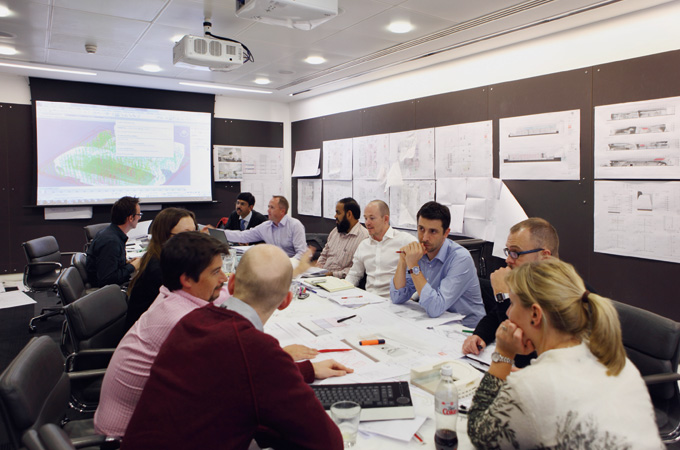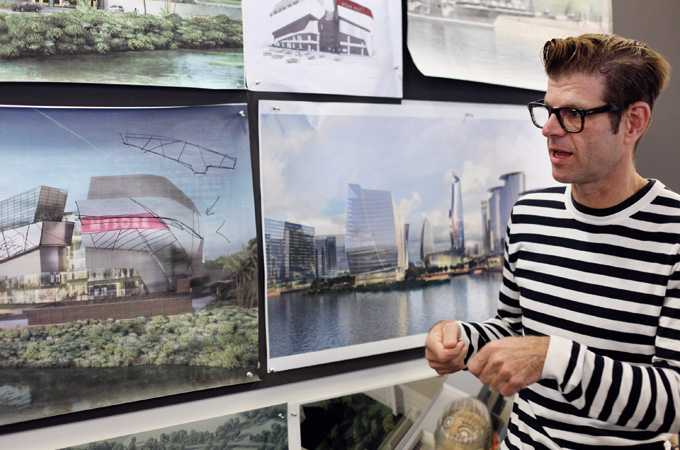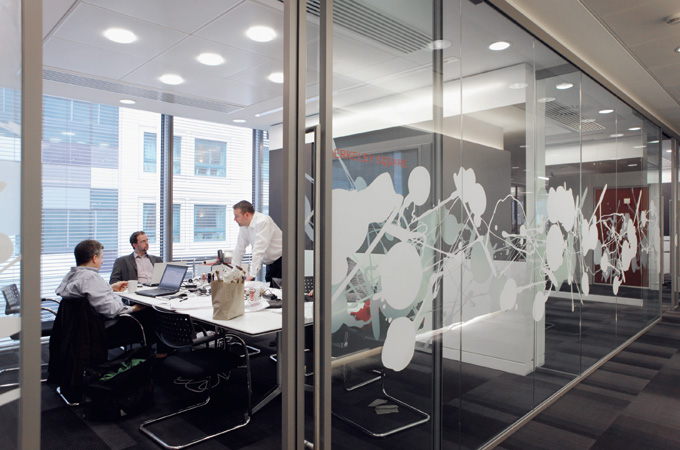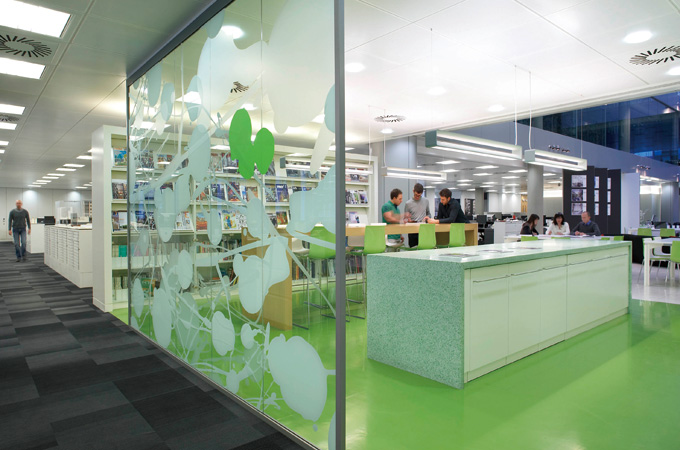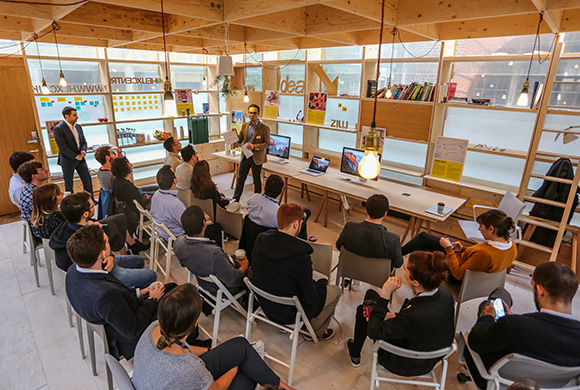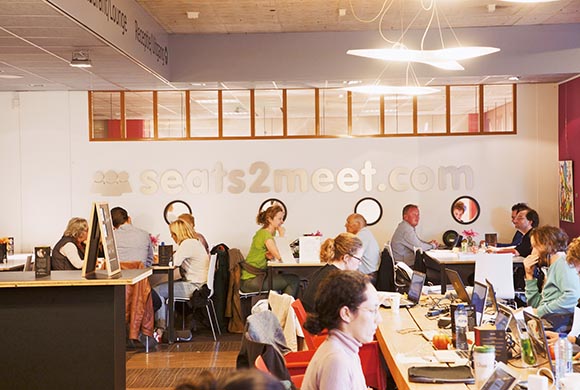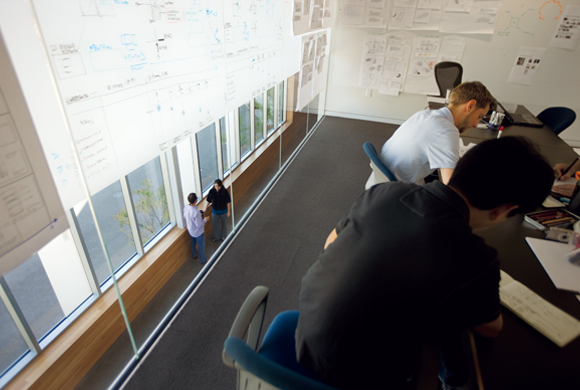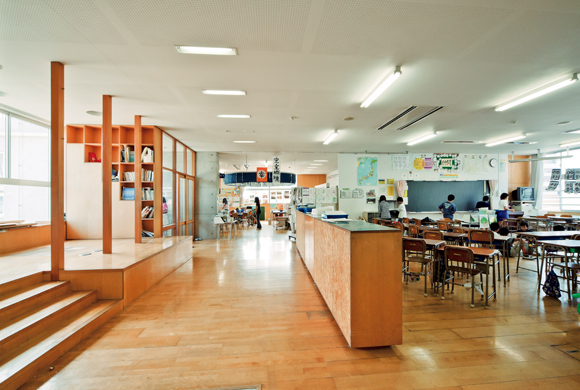Workplace
Nov. 5, 2012
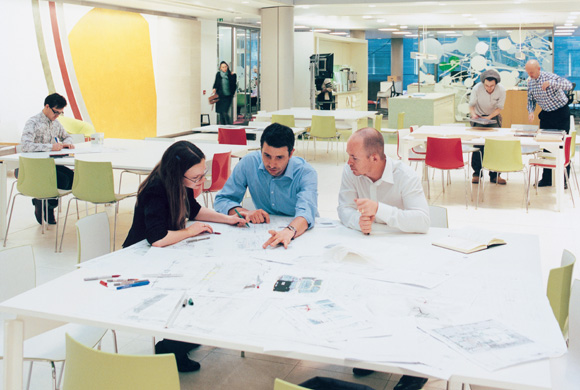
The Exhibition for Innovation and Collaboration
A world-class architectural firm
[HOK London] Camden, London, UK
Three years ago, when the lease in Oxford Circus was due to expire, the feedback was that the HOK London collaboration space had simply become too small. The importance of communication is highly valued in the HOK Group culture, and is an idea that is well established in all of the company’s 25 worldwide offices.
Another strongly-felt opinion was that, along with a bigger collaboration space, the company also needed small meeting rooms that could be easily used without requiring reservations. At the same time, staff also expressed that they wanted more display space.
This, they said, was something they had learned from experience: that a place to exhibit design work where it would be easily seen by both clients, visitors and other teams within the company a sort of showcase was very much needed.
Behind the desire for more collaboration was the fact that the firm was increasingly diversifying into municipal and institutional planning, and that national and city building standards are becoming tighter each year.
The deciding factor for the current office was the atrium space. This was a place where meetings could be held without requiring reservations, where clients and visitors could be present right where idea generation takes place, with a kitchen also set right alongside¬タヤin short, a place for informal exchanges. By moving desks out of the way, the space could easily be used as a multipurpose event space as well.
After the move was completed, an event was held to celebrate HOK’s work in the Aviation Sector. In 2011, HOK was doing a great deal of airport-related work, so HOK Airways was created as the theme for the appearance of a fictitious airport in the open space.
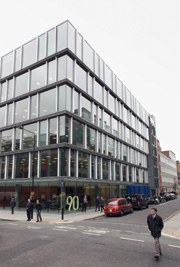 Founded 1955 in the US
Founded 1955 in the US
2010 sales: US$47 billion Employees: Approximately 1,700 Offices: 25 locations in 11 countries
HOK opened its European headquarters in the Holborn area of London in 1987. It relocated its offices to Whitfield Street, from Oxford Circus, in 2009.
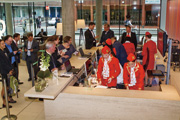 A scene from 2011’s HOK Airways event. Clients were enter- tained by employees dressed as pilots and cabin attendants.
A scene from 2011’s HOK Airways event. Clients were enter- tained by employees dressed as pilots and cabin attendants.
A runway was built on the floor; a check-in area and security gate were constructed; and Republic of HOK passports and boarding passes were all prepared. This wasn’t a normal party to thank guests and employees, but was intended to be a full production, entirely created by the employees and showcasing their creativity and technological skills.
Accordingly, the group work for the event was a confirmation of the employees’ ability to work cooperatively, while using their specialist skills as well. At HOK London, normally about 300 projects are under way at any given point in time.
Employees gather in this breakout space when there is an important announcement to be made, and on every First Friday of the month an informal gathering is also held here. For the latter, wine and beer and snacks are served, while project presentations are held and promotions are announced.
For major projects being developed with global teams, the members will often gather in London for two days of discussion. In the boardroom, 15 people can gather around the large table; diagrams can be mounted on the walls so that everyone can go over the project together. Often details will be illustrated with the use of 3D digital drawings or hand-drawn sketches.
Employees are often moving between their own desks and the breakout space, but they also have a round breakout table behind their desk, so they can move from concentrated work to immediately begin bouncing ideas with the other members of their team.
The kitchen isn’t just a place for a break or a meal, but is often used for casual meetings or lunchtime sessions. Because of the flexible-use spaces established within the office building, consultants or engineers brought in to work on projects from the outside can also be easily be set up in the office on a long-term basis.
Large wall spaces for displaying works have also been set up around the desk areas of each team. Diagrams can be quickly mounted just prior to their completion, so that other members can point out things that might be changed, or make some alteration notes or sketches.
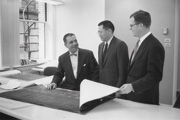 The men who first established HOK were three well-known American architects, Hellmuth, Obata and Kassabaum. Hellmuth had a joint office with Minoru Yamasaki, the man who designed the World Trade Center in New York, but Yamasaki’s illness caused him to pull out of the partnership. Old friends Obata and Kassabaum, who had their own office, were then brought togeth- er with Hellmuth. The three men hit it off right away, and decided to establish HOK.
The men who first established HOK were three well-known American architects, Hellmuth, Obata and Kassabaum. Hellmuth had a joint office with Minoru Yamasaki, the man who designed the World Trade Center in New York, but Yamasaki’s illness caused him to pull out of the partnership. Old friends Obata and Kassabaum, who had their own office, were then brought togeth- er with Hellmuth. The three men hit it off right away, and decided to establish HOK.
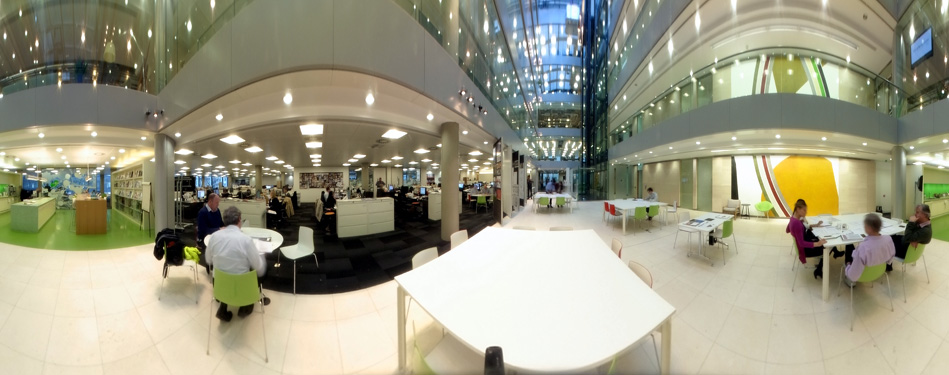
The breakout space, in the center of the office. It’s used for everything from employees regularly sharing ideas or collaborating, as well as an event space.
 360°View
360°ViewThe breakout space, in the center of the office. It’s used for everything from employees regularly sharing ideas or collaborating, as well as an event space.
*Touch Picture for 360° View
On top of the plan chest, a space for storing materials is an area where models and other items can be kept, and also serve as display space. The chest has been designed to be at a height so that, as other teams or clients pass by, they can quickly get a glance at the materials, allowing the works and technical developments to be widely seen.
The interiors team are currently exploring redesigning the meeting room located near to the entrance, regularly as an opportunity for them to showcase their high-level skills. This isn’t just the furniture, but an experimental display of wall and floor materials as well.
Employees at HOK are assigned to specific design groups, but because the work is on a project basis, the changing team size and phase of the project means that employees are constantly moving from project to project, and moving to different areas in the office to join another team.
Also, they are likely to be working on several projects the same time. Therefore, depending on colleagues and the project goals, the place where they work will change.
HOK’s IT strength is in infrastructure planning, and are working on an online, mutual communication environment that allows for a higher level of resource management. Designers are frequently collaborating, their diverse skills are enhanced and their inspiration increases.
HOK employees are involved in several projects at any one time, because working with different countries and on different subjects builds on their expertise. In group work, the one thing you can’t say to your fellow team mates is ‘no’. They are known for their high level of commitment.
So to recruit new talent successfully, the candidate will be interviewed by potential team members, and the decision is made on if the individual has the right skills and if they fit into the working culture.
From WORKSIGHT 02(Jun.2012)
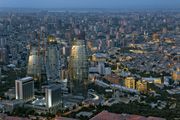 HOK has worked on many famous global projects, from Heath- row Airport at home in London, to the Dubai Marina and many others. Current representative projects include the New Doha International Airport, US headquarters for Canon and Porsche (all scheduled for completion in 2012), and others. This photo is the new Flame Towers resi- dential, office, hotel and retail development in Baku, Azerbaijan
HOK has worked on many famous global projects, from Heath- row Airport at home in London, to the Dubai Marina and many others. Current representative projects include the New Doha International Airport, US headquarters for Canon and Porsche (all scheduled for completion in 2012), and others. This photo is the new Flame Towers resi- dential, office, hotel and retail development in Baku, Azerbaijan


